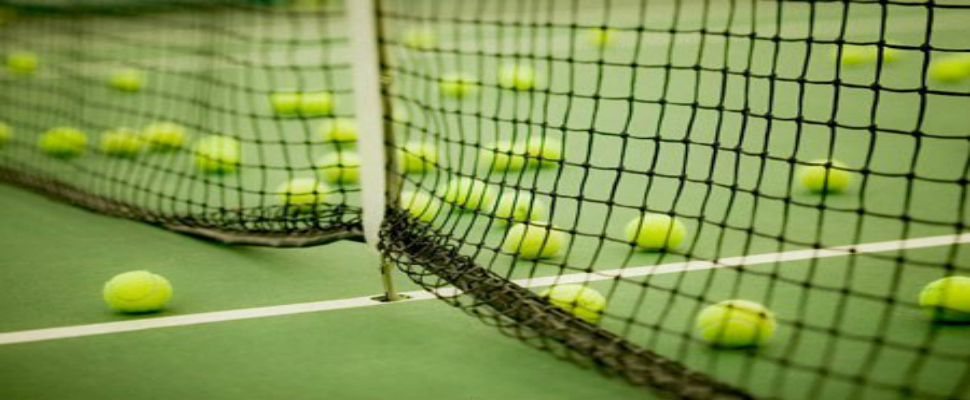TENNIS
Fitness Demands of a Tennis Match From Complete Conditioning for Tennis by United States Tennis Association
Researchers characterize tennis as a sport in which players must respond to a continuous series of emergencies. Sprinting to the ball, changing directions, reaching, stretching, lunging, stopping, and starting. All these characteristics, combined with maintaining proper balance and technique throughout a match, are critical for optimal performance on the court. Therefore, players must address flexibility, strength and endurance, power, agility and speed, body composition, and aerobic and anaerobic fitness to improve their tennis games. What follows is a brief overview of the components of fitness for tennis players.
Flexibility
Tennis requires you to make shots that place your body parts in extreme ranges of motion (e.g., when your arm is fully extended over your head reaching for a lob). Throughout a match you are called on to generate great force from a variety of body positions; changing direction, reaching for a shot, stopping quickly, and serving are a few examples. Strength throughout a flexible, unrestricted range of motion will help prevent injury and enhance performance.
Strength and Endurance
Have you ever played in a long match that made your muscles sore the next day? Well, that’s because tennis requires you to have not only good strokes, but also excellent strength and muscular endurance. Throughout a match, you may hit hundreds of balls while running from side to side. Good muscular endurance, which means that you can apply force and sustain it over time, can help you hit the ball just as hard at the end of a match as at the beginning. Also, it can help prevent injuries.
Power
Tennis requires explosive movements. Greater power allows you to respond more quickly and produce forceful movements with less effort. Players with explosive first steps get into position quickly, set up well, and hit effective shots. In addition, an explosive first step will give you the speed to get to balls hit farther away. Both upper and lower body power are necessary in tennis. To maximize your power, you must transfer your lower body power to the upper body.
Agility and Speed
Agility is crucial to good court movement. It allows you to be in the correct position and provides a solid platform from which to hit the ball. In a typical five-second point, there may be as many as four direction changes. Speed is important to get to the ball. Though some people have natural speed, others can achieve this by training their muscles and nervous systems to produce the same effect. The faster you can get to a ball, the more time you have to prepare for your shot.
Optimum Body Composition
The amount of bone and water your body consists of remains constant, so you should pay attention to muscle and fat when attempting to alter body composition. You can increase the amount of muscle in the body through proper strength training. However, it is not enough to increase muscle mass; you also must maintain an appropriate level of body fat. The two ways to affect body fat are fat-loss dieting and aerobic exercise. Fat-loss dieting, which is the correct term for a weightloss diet because you are attempting to decrease fat in particular, is a method of decreasing fat intake while maintaining an adequate caloric intake. Along with using fat as an energy source, aerobic exercise will improve your endurance in longer matches. Body fat percentages to shoot for are approximately 8 to 18 percent for men and 15 to 25 percent for women. By following a balanced diet and including aerobic exercise (a few sets of tennis) in your training regimen, these percentages will be attainable.
Anaerobic and Aerobic Fitness
What’s the best way to train for tennis? To answer that question, let’s look at the energy demands of the sport. The energy used in a long-distance race comes from the aerobic (with oxygen) system, and the energy used in short bursts of activity, such as a 20-yard dash, is called anaerobic (without oxygen). Although it is difficult to quantify the energy demands of tennis, we know that it is a sport that relies on strong aerobic and anaerobic systems.
Most points in tennis, even on a clay court, last less than 10 seconds, whereas the average point on a hard court between two equally matched players lasts approximately 5 seconds. A player may expend 300 to 500 short bursts of effort during a match. Each short burst of effort is an anaerobic activity. So, obviously anaerobic training is important.
Does that mean you can ignore aerobic training? No! In a tennis match you have 25 seconds of rest between points and 90 seconds between games. If your aerobic fitness is low, it is difficult to recover between points and games, and you are likely to get tired at the end of a match. Another advantage of a strong aerobic base is that it provides you with the endurance to have quality workouts. Therefore, because matches can last a long time and players must recover quickly between points, aerobic fitness is key as well.
All these components of physical fitness are important in developing your game. To help you create an appropriate program that enhances your performance, reduces injury risk, and increases your lifetime enjoyment in the game, start by designing a proper periodization training program.
Fitness Demands of a Tennis Match From Complete Conditioning for Tennis by United States Tennis Association
Researchers characterize tennis as a sport in which players must respond to a continuous series of emergencies. Sprinting to the ball, changing directions, reaching, stretching, lunging, stopping, and starting. All these characteristics, combined with maintaining proper balance and technique throughout a match, are critical for optimal performance on the court. Therefore, players must address flexibility, strength and endurance, power, agility and speed, body composition, and aerobic and anaerobic fitness to improve their tennis games. What follows is a brief overview of the components of fitness for tennis players.
Flexibility
Tennis requires you to make shots that place your body parts in extreme ranges of motion (e.g., when your arm is fully extended over your head reaching for a lob). Throughout a match you are called on to generate great force from a variety of body positions; changing direction, reaching for a shot, stopping quickly, and serving are a few examples. Strength throughout a flexible, unrestricted range of motion will help prevent injury and enhance performance.
Strength and Endurance
Have you ever played in a long match that made your muscles sore the next day? Well, that’s because tennis requires you to have not only good strokes, but also excellent strength and muscular endurance. Throughout a match, you may hit hundreds of balls while running from side to side. Good muscular endurance, which means that you can apply force and sustain it over time, can help you hit the ball just as hard at the end of a match as at the beginning. Also, it can help prevent injuries.
Power
Tennis requires explosive movements. Greater power allows you to respond more quickly and produce forceful movements with less effort. Players with explosive first steps get into position quickly, set up well, and hit effective shots. In addition, an explosive first step will give you the speed to get to balls hit farther away. Both upper and lower body power are necessary in tennis. To maximize your power, you must transfer your lower body power to the upper body.
Agility and Speed
Agility is crucial to good court movement. It allows you to be in the correct position and provides a solid platform from which to hit the ball. In a typical five-second point, there may be as many as four direction changes. Speed is important to get to the ball. Though some people have natural speed, others can achieve this by training their muscles and nervous systems to produce the same effect. The faster you can get to a ball, the more time you have to prepare for your shot.
Optimum Body Composition
The amount of bone and water your body consists of remains constant, so you should pay attention to muscle and fat when attempting to alter body composition. You can increase the amount of muscle in the body through proper strength training. However, it is not enough to increase muscle mass; you also must maintain an appropriate level of body fat. The two ways to affect body fat are fat-loss dieting and aerobic exercise. Fat-loss dieting, which is the correct term for a weightloss diet because you are attempting to decrease fat in particular, is a method of decreasing fat intake while maintaining an adequate caloric intake. Along with using fat as an energy source, aerobic exercise will improve your endurance in longer matches. Body fat percentages to shoot for are approximately 8 to 18 percent for men and 15 to 25 percent for women. By following a balanced diet and including aerobic exercise (a few sets of tennis) in your training regimen, these percentages will be attainable.
Anaerobic and Aerobic Fitness
What’s the best way to train for tennis? To answer that question, let’s look at the energy demands of the sport. The energy used in a long-distance race comes from the aerobic (with oxygen) system, and the energy used in short bursts of activity, such as a 20-yard dash, is called anaerobic (without oxygen). Although it is difficult to quantify the energy demands of tennis, we know that it is a sport that relies on strong aerobic and anaerobic systems.
Most points in tennis, even on a clay court, last less than 10 seconds, whereas the average point on a hard court between two equally matched players lasts approximately 5 seconds. A player may expend 300 to 500 short bursts of effort during a match. Each short burst of effort is an anaerobic activity. So, obviously anaerobic training is important.
Does that mean you can ignore aerobic training? No! In a tennis match you have 25 seconds of rest between points and 90 seconds between games. If your aerobic fitness is low, it is difficult to recover between points and games, and you are likely to get tired at the end of a match. Another advantage of a strong aerobic base is that it provides you with the endurance to have quality workouts. Therefore, because matches can last a long time and players must recover quickly between points, aerobic fitness is key as well.
All these components of physical fitness are important in developing your game. To help you create an appropriate program that enhances your performance, reduces injury risk, and increases your lifetime enjoyment in the game, start by designing a proper periodization training program.

Tennis Training on Long Island














